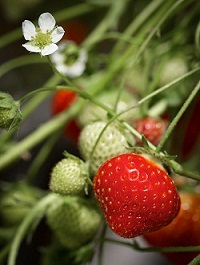Planting Strawberry | Growing Strawberries
Sweet, sharp and crisp; strawberry is the only fruit you can grow everywhere: In hanging baskets, borders, in upside down planters, window boxes, pots, and garden beds. Plus, ‘Planting strawberry’ is easy too, so why not grow your own and enjoy it fresh.
Difficulty: Easy
Soil pH: Slightly acidic, around 5.5 – 6.8 pH
Choosing right variety
Choose whether you want to grow strawberries as annual or perennial.
There are three types of strawberry varieties:
June bearer or summer fruiting, which bear fruits once in a year in summer and grown as annual. This type of varieties produces juiciest and biggest strawberries. Everbearing varieties bear fruits twice in summer and fall. The third type of varieties are called day-neutral, this type of strawberries are hybrids and grows well all year round if right growing conditions are provided.
Planting Method
Basically, there are four methods to plant strawberries.
Runners: These are thin pieces of roots with a few leaves; runners are the cheapest source to plant strawberries.
Misted Tips: Plant grown from misted tips are less prone to disease and grows better, actually misted tips are the tips of the mother plant.
Cold-stored runners: Runners stored in cold store for a long period are used for planting after winter.
Potted plants: You can buy potted plants from garden centers; this is the easiest method to grow strawberries.
Soil Preparation
Find out whether your soil is alkaline or acidic; amend your soil if it is alkaline. Strawberry prefers rich loamy soil, make it more loam using compost or manure, rotted sawdust and organic matter. You can also use coffee grounds and compost tea to increase soil acidity and fertility.
Planting Strawberry
Choose a planting method that suits you and buy a plant from a reputable source. Prefer less windy, frost free and fertile spot with good drainage that receives at least six hours of direct sunlight for planting.
Plant strawberries on raised beds in rows leaving space of 15’’ – 18’’ between plants and 3 – 4 feet between rows because most of the strawberry verities develop many runners.
If you’re growing a day-neutral or everbearing strawberry variety then only leave 6 inches space between plants and allow only two runners to grow from the mother plant, because everbearing and day-neutral varieties have fewer runners and small fruits, this will allow the mother plant to grow more vigorously.
Make sure while planting that you don’t plant it too deep so that its crown (the point where the stem and root of the plant join) or leaves won’t be covered in soil. After plantation, add mulch to prevent weed and keep up moisture.
Strawberry planting is the key for a healthy upright plant, take special care that you plant it at the correct depth.
Watering and Fertilizing
Water deeply and frequently without letting the soil dry out completely, avoid overwatering. When plants are establishing, forming flowers and fruits, water requirement should be increased. *Don’t water from overhead as this can cause crown rot and loss of the plant.
Strawberry roots are shallow so they need moisture frequently in growing season, drip irrigation method is favorable.
Feed the plants with 10-10-10 fertilizer twice, once when the growth begins and after the last harvest. Use half of pound (230 Gm) for every 100 feet rows. You can also feed plants with potassium-rich liquid fertilizer every other week during the growing season.
Care
Don’t allow your plant to bring out so many runners, for better yield.
After every growing season cut back the plants’ foliage to one inch, this will not only refresh the plants but also discourage the possible fungal diseases.
Strawberry plants after the third year of cropping produce fewer fruits and become more susceptible to diseases and pests. After this period rotate your strawberry crop and grow new plants.
Avoid planting strawberries on the site where plants of Solanaceae family (egg plants, tomatoes, peppers) were previously planted.
If you’re growing strawberries as perennial, pick off the flowers to discourage fruiting in the first growing season to encourage better yield in the next seasons.
Mulch heavily around the bedding in the winter when the temperature reaches the freezing point, as the temperature below 30 F is damaging for the strawberry plant.
Harvest
After a month of blossoming, fruit is ready to be picked. Pluck off a fruit only when you see it red and ripe, harvest regularly because once a fruit is ripening, it rots quickly.
Pests and Diseases
Birds are the main predators, they love berries, use fruit cages or nets to get rid of them. Powdery mildew, gray mold, spider mites, and slugs are the common pests that infect the plants.
Strawberries are also subject to fruit rot, root rot, and fungus. *Use row covers to protect plants from pests and temperature drop.



No comments:
Post a Comment